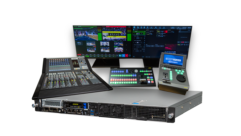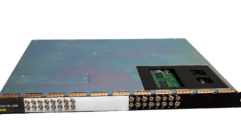
HDTV Fountain of Youth
Aug 1, 2006 12:00 PM,
By Josh Allen
Video processors improve HD imagery—and your bottom line.

Home theater processors/scalers such as DVDO’s iScan VP30 will help you get
the most out of your HDTV.
With all the hype surrounding high-definition displays, 1080p, and the all-digital future of television broadcasting, it’s surprising that more industry professionals don’t understand the benefits of video processors. Multiple inputs and outputs and an array of tweakable features allow most video processors to serve as complete AV hubs. This development stands in stark contrast to the video scalers of yore, which cost $10,000 and functioned as mere line doublers. Fortunately, the category is expanding, and there are several reasonably priced processors on the market today that deliver functionality and value.
Scaling is, perhaps, the most important function of a video processor. Simply put, scaling in video means reformatting the picture through various algorithms, to occupy more or fewer scan lines than it did before, without cropping of subject material. For digital video, scaling also refers to reformatting the picture to occupy more or fewer pixels across each scan line, again without cropping the subject matter. All scaling in video requires converting the video to digital form and then processing it, otherwise referred to as “working in the digital domain.”
EXTERNAL ADVANTAGES
Much like the line doublers and quadruplers of the 1990s that converted TV video to computer video formats for high-resolution LCD and DLP projectors, today’s video scalers have become essential home theater components for those who have invested in next-generation HD displays — especially 1080p. In fact, video scaling has become such an integral part of the home theater equation that nearly all HD displays are now being equipped with internal scaling engines.
Still, despite this fact, there remain crystal-clear advantages to using external video scalers/processors for many applications.
A high-quality video scaler is more than just an upconverter designed to change resolutions from lower to higher. It is also a sophisticated video processor, with the ability to make adjustments for motion, convert from film to video, and change aspect ratios while serving as a complete AV hub and switcher. Although an internal video scaler may help with less visible flicker or horizontal lines, true film-like quality cannot be achieved without a well-equipped external processor. Many of the internal processors present in high-definition displays do an inadequate job of scaling and de-interlacing video signals because they are not equipped to effectively handle all resolutions.

NEC TheaterSync with Silicon Optix HQV (Hollywood Quality Video) technology
A common trap many consumers fall into occurs when they purchase an HD- or 1080p-capable display and hook up all of their video sources. The assumption is that every DVD they own and all of their favorite TV shows will magically look better because of the shiny new plasma TV. Many consumers simply aren’t making the connection that you have to actually be watching the HD feed of a program or source in order to enjoy HD’s benefits. They think that because their TV has a high-def logo on it, everything they see is high def, when, in fact, the opposite is true. Blowing up an NTSC image on a 50in. plasma TV makes it look worse than it did on a 32in. direct-view analog TV. Artifacts such as jaggies and MPEG noise that aren’t noticeable on a smaller standard-definition TV become much more apparent and annoying when the image is blown up on a big screen.
Scaling in video is not a new concept, and forms of it can be seen every time the TV is turned on. For sports-obsessed fans, the ticker streaming up-to-date stats at the bottom of the screen is a result of video production scaling. The picture in picture (PIP) option that allows your child to watch The Wiggles while you struggle to see how your investments fared on the Dow is a scaled-down video picture. Almost all DVD players include a simple scaler. Pop in a rented anamorphic DVD (enhanced for 16:9 and displayed on a 4:3 TV), and the player will optionally scale the 480 scan lines of picture to occupy 360 scan lines and add “black bars” — 60 black lines on the top and bottom (something a high-quality video processor can eliminate with no corrupting effects to the image).
On top of the performance benefits a video processor offers, there are additional advantages for the AV pros who sell them. The most affordable processors start at around $2,000 and can cost upwards of $5,000. Because HDTV sales are though the roof, albeit with less-than-ideal margins, video processors can be a valuable, revenue-driving accessory to those who want the best from their new HD display purchase.
For some, it may seem like spending another $2,000 on a video processor when they have already purchased an HDTV is a bit excessive. But consider this: If someone goes out and buys a $6,000 1080p display, they would seemingly have enough bankroll to spend a couple thousand more to ensure all their legacy sources can be enjoyed at their absolute best. Likewise, someone who is unsure if they want something high-end would be better suited to go with a less expensive 1080i display and invest the money saved on a good video processor.

TV One C2-7100
1080P’S ROLE
The emergence of 1080p has certainly been a boost to the video processor category. If you have a pulse in this industry, then you’ve heard of the popular high-definition resolutions, 720p (720 progressive) and 1080i (1080 interlaced). But 1080p is superior to both. What is 1080p? Quite simply, if you were able to count the vertical pixels on a 1080p display, there would be 1,080 of them, while the horizontal pixels total 1,920 (you’ll typically see this expressed as 1920×1080). 1080p is the highest-resolution high-definition standard, and until we abandon ATSC (the current standard used by all major television stations), this is the best picture you can have in your home.
The only available high-definition broadcast signals right now are 720p and 1080i. Many television programs are broadcast over the air, or via satellite and cable companies in one of these two formats. However, both HD-DVD and Blu-ray formats are encoded at 1080p resolution. Because of this, the new formats bring up the issue of scaling a higher-resolution signal to a common, lower-resolution display such as 720p.
It’s hard to say which one of these competing formats will come out victorious. Given that there is very little material available in the 1080p format, consumers must install a video processor with their legacy sources to take advantage of this exciting new technology. By using a 1080p outboard video processor, a 720p signal (1,280 horizontal pixels by 720 vertical pixels) can be scaled up to 1920×1080 pixels. A 1080i signal needs to be de-interlaced (a process by which the interlaced signal is converted into a progressive one) to 1080p, just like a progressive scan DVD player can de-interlace the signal on a DVD and produce a 480p picture from a 480i disc.

An unscaled video image. Note the serious jaggies on the cello bow and drumsticks in the background.
All standard-definition signals, be it from your satellite or cable box or any other SD source, also need to be converted from their much lower resolution up to 1080p. Forthcoming 1080p displays will naturally have this processing built in, but, admittedly, this form of internal processing is no match for the quality of picture that can be realized when using a high-quality outboard video processor. Think of it as adding an after-market high-performance part to your vehicle. Sure, the car from the factory runs just fine the way it is, but adding a product that was specifically designed to give it more horsepower improves the experience in a way the factory just can’t match.

Scaling has improved this image dramatically.
Images courtesy DVDO
I believe that most consumers will be thrilled with the picture quality of a 1080p display for the next five years, if not longer. It is a fine line for consumers who want to get the absolute best picture, while balancing the fear of buying a display that may end up being obsolete. If the display does not limit the resolution of the source, then all we need are 1080p sources, which are just starting to trickle out. Although these external sources are being developed and should hit with full force within a year or two, it will be some time before anyone receives 1080p broadcast signals. Until then, a signal scaled with a 1080p processor remains the best option.
The misconceptions about 1080p and HD programming certainly make video scaling and processing more relevant as early adopters spend thousands on full HD displays incapable of outputting their “golden resolution” because of inadequate source material. The newest video processors can upscale to 1080p, de-interlace, downscale, route, and act as AV switching hubs — all while offering advanced picture and aspect ratio controls.
Find a display with an internal scaler that can accomplish all of these tasks, and you’ve found the Holy Grail of high definition. It doesn’t exist. And until it does, video processors are the fountain of youth for HDTV, and a valuable revenue stream for AV pros.
Josh Allenis iScan product manager for DVDO, a privately held company based in Campbell, Calif., that designs, manufactures, and markets solutions for the next generation of digital television and digital video electronic products.










